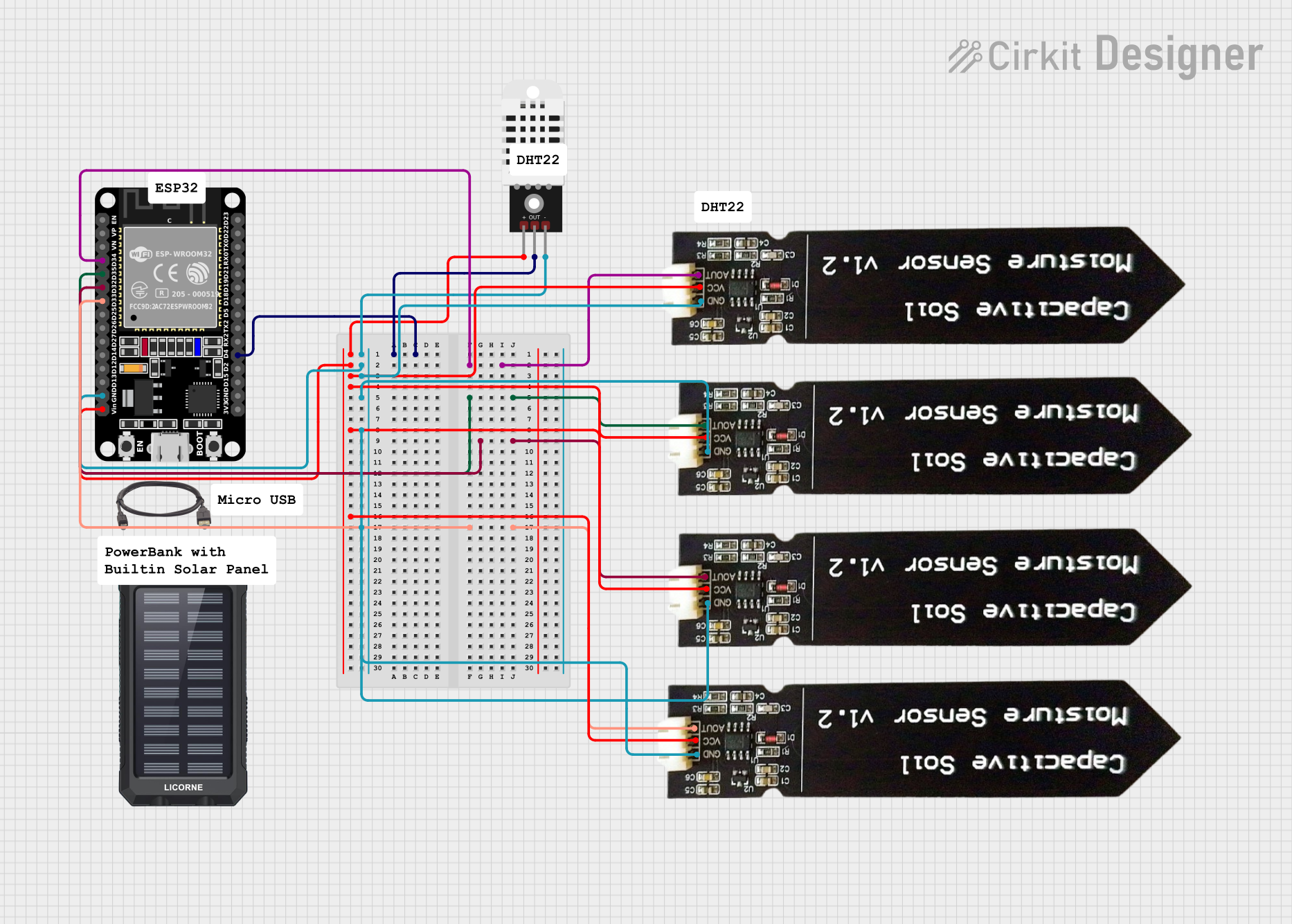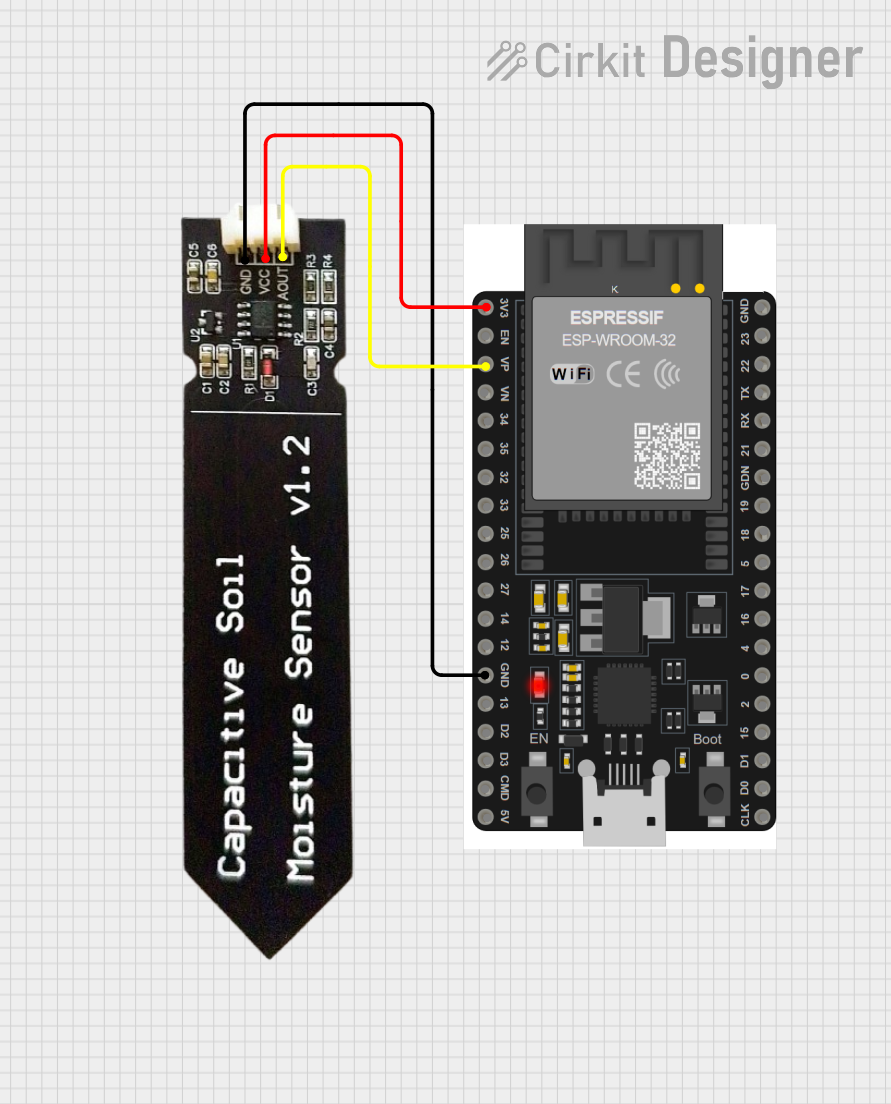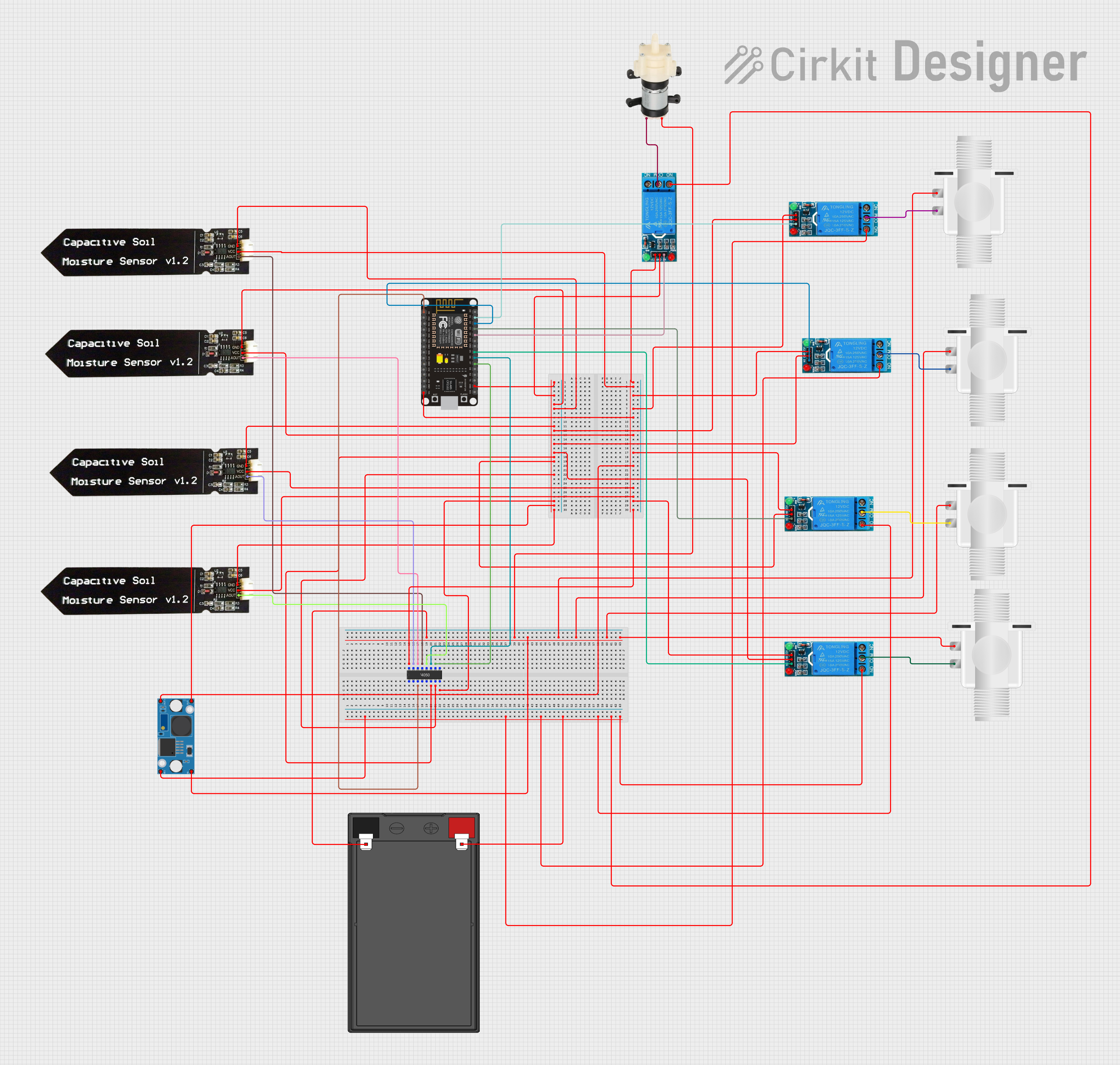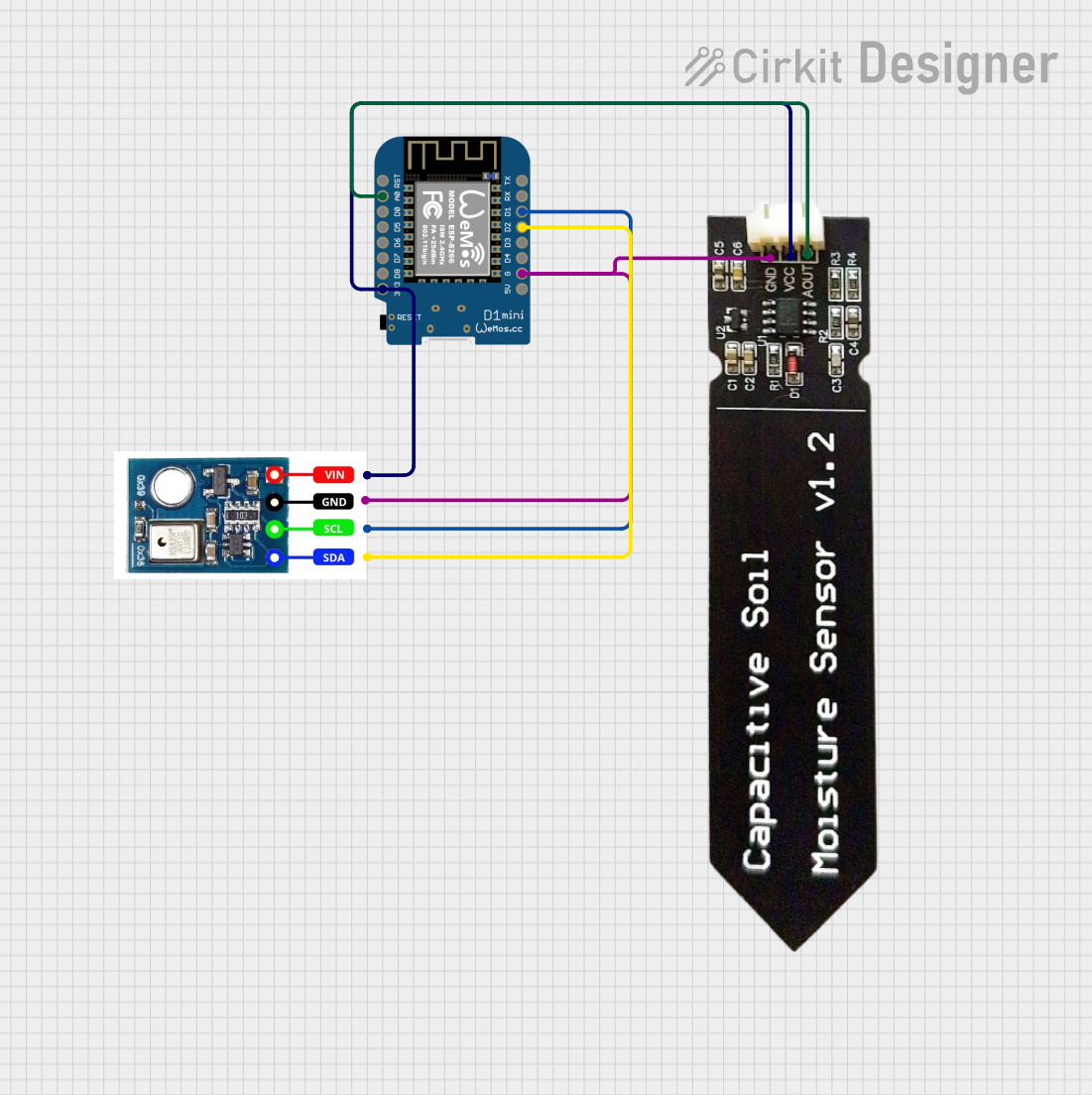
How to Use Capacitive Soil Moisture Sensor M2: Examples, Pinouts, and Specs

 Design with Capacitive Soil Moisture Sensor M2 in Cirkit Designer
Design with Capacitive Soil Moisture Sensor M2 in Cirkit DesignerIntroduction
The Capacitive Soil Moisture Sensor M2 is a reliable and efficient device designed to measure the volumetric water content in soil. Unlike resistive soil moisture sensors, this capacitive sensor detects changes in soil capacitance, which varies with moisture levels. This design ensures better durability and resistance to corrosion, making it ideal for long-term use in agricultural, gardening, and environmental monitoring applications.
Explore Projects Built with Capacitive Soil Moisture Sensor M2

 Open Project in Cirkit Designer
Open Project in Cirkit Designer
 Open Project in Cirkit Designer
Open Project in Cirkit Designer
 Open Project in Cirkit Designer
Open Project in Cirkit Designer
 Open Project in Cirkit Designer
Open Project in Cirkit DesignerExplore Projects Built with Capacitive Soil Moisture Sensor M2

 Open Project in Cirkit Designer
Open Project in Cirkit Designer
 Open Project in Cirkit Designer
Open Project in Cirkit Designer
 Open Project in Cirkit Designer
Open Project in Cirkit Designer
 Open Project in Cirkit Designer
Open Project in Cirkit DesignerCommon Applications and Use Cases
- Smart irrigation systems: Automating watering schedules based on soil moisture levels.
- Gardening and agriculture: Monitoring soil conditions for optimal plant growth.
- Environmental monitoring: Measuring soil moisture in research and conservation projects.
- DIY projects: Integrating with microcontrollers like Arduino for hobbyist applications.
Technical Specifications
- Operating Voltage: 3.3V to 5.5V
- Output Type: Analog voltage (proportional to soil moisture level)
- Current Consumption: < 20mA
- Interface: Analog or digital output
- Dimensions: 98mm x 23mm x 3mm
- Material: Corrosion-resistant PCB
- Operating Temperature: -40°C to 85°C
Pin Configuration and Descriptions
The Capacitive Soil Moisture Sensor M2 has a 3-pin interface. The table below describes each pin:
| Pin | Name | Description |
|---|---|---|
| 1 | VCC | Power supply pin. Connect to 3.3V or 5V. |
| 2 | GND | Ground pin. Connect to the ground of the power supply or microcontroller. |
| 3 | AOUT | Analog output pin. Provides a voltage proportional to the soil moisture level. |
Usage Instructions
How to Use the Sensor in a Circuit
Wiring the Sensor:
- Connect the VCC pin to the 3.3V or 5V power supply of your microcontroller.
- Connect the GND pin to the ground of your microcontroller.
- Connect the AOUT pin to an analog input pin on your microcontroller (e.g., A0 on an Arduino UNO).
Placement:
- Insert the sensor into the soil at the desired depth. Ensure the sensor's PCB is fully in contact with the soil for accurate readings.
- Avoid placing the sensor in waterlogged soil for extended periods, as this may affect accuracy.
Reading the Output:
- The sensor outputs an analog voltage that decreases as soil moisture increases. Dry soil results in a higher voltage, while wet soil results in a lower voltage.
Important Considerations and Best Practices
- Calibration: Calibrate the sensor for your specific soil type to improve accuracy. Record the sensor's output voltage for dry and saturated soil, and use these values to map the voltage to moisture levels.
- Power Supply: Use a stable power supply to avoid fluctuations in readings.
- Environmental Protection: While the sensor is corrosion-resistant, avoid prolonged exposure to water or extreme conditions to extend its lifespan.
- Avoid Damage: Do not bend or apply excessive force to the sensor's PCB.
Example Code for Arduino UNO
The following code demonstrates how to read the sensor's analog output using an Arduino UNO and display the moisture level in the Serial Monitor.
// Define the analog pin connected to the sensor
const int sensorPin = A0;
void setup() {
// Initialize the Serial Monitor for debugging
Serial.begin(9600);
}
void loop() {
// Read the analog value from the sensor
int sensorValue = analogRead(sensorPin);
// Map the sensor value to a percentage (0% to 100%)
// Adjust the min and max values based on calibration
int moisturePercent = map(sensorValue, 1023, 300, 0, 100);
// Print the moisture level to the Serial Monitor
Serial.print("Soil Moisture: ");
Serial.print(moisturePercent);
Serial.println("%");
// Wait for 1 second before the next reading
delay(1000);
}
Troubleshooting and FAQs
Common Issues and Solutions
Inconsistent Readings:
- Cause: Unstable power supply or loose connections.
- Solution: Ensure all connections are secure and use a regulated power supply.
No Output or Incorrect Values:
- Cause: Incorrect wiring or damaged sensor.
- Solution: Double-check the wiring and ensure the sensor is not physically damaged.
Sensor Not Responding:
- Cause: Soil is too dry or sensor is not properly inserted.
- Solution: Ensure the sensor is fully inserted into the soil and check the soil condition.
Corrosion or Damage:
- Cause: Prolonged exposure to waterlogged soil or harsh conditions.
- Solution: Use the sensor in well-drained soil and avoid submerging it in water.
FAQs
Q1: Can this sensor be used with a Raspberry Pi?
Yes, the sensor can be used with a Raspberry Pi. However, since the Raspberry Pi does not have built-in analog input pins, you will need an external ADC (Analog-to-Digital Converter) module to read the sensor's output.
Q2: How do I calibrate the sensor?
To calibrate, measure the sensor's output voltage in completely dry soil and fully saturated soil. Use these values to map the sensor's output to a percentage or other meaningful scale.
Q3: Is the sensor waterproof?
The sensor is water-resistant but not fully waterproof. Avoid submerging it in water for extended periods to prevent damage.
Q4: Can this sensor measure moisture in other materials?
The sensor is optimized for soil but may work with other porous materials. Calibration is required for accurate results.